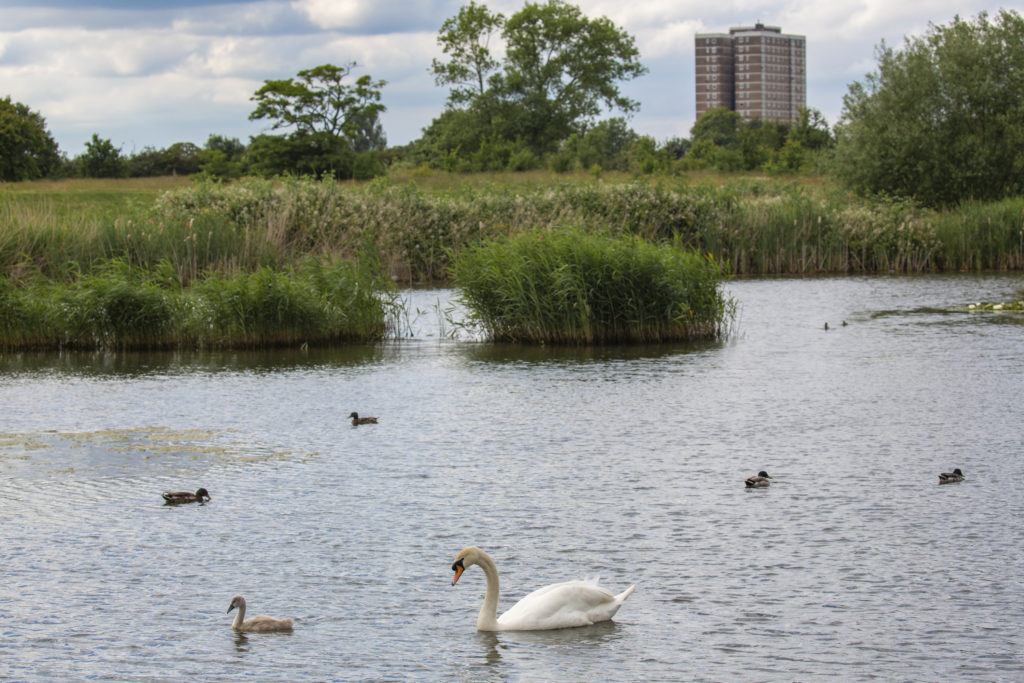As London Rivers Week celebrates London’s 600km of river, Kirsten Downer from river charity Thames21 talks about efforts to rewild the network.

I remember when I first realised that a river ran beside the busy A20 in Lewisham. I was standing outside Aldi, waiting for my partner to finish his beer shopping, when a shock of brilliant aquamarine caught my eye at the edge of the carpark. I walked over, and on the other side of a concrete wall I saw a burbling stream. I realised that I just seen my first kingfisher, in the least glamorous location possible.
That was my introduction to the river Quaggy, which rises just outside London in the borough of Bromley, where it is known as Kid’s Brook. From there it wiggles its way through the suburbia of Bromley and Greenwich, changes its name to Quaggy, joins the Ravensbourne river in Lewisham and finally flows into the Thames at Deptford.
The Quaggy is known as one of the most engineered rivers in the UK. Like many of London’s rivers, much of it runs through concrete channels and under roads in culverts. But at least it spends most of its life above ground – not the case with some of our rivers. There’s a map of the Thames basin catchment we use in our Thames21 trainings. Twenty or so mighty rivers, blue marks on the map, converge on London and the Thames and then suddenly vanish.

Except of course, these rivers haven’t vanished. They run beneath our feet as ghost rivers, purdahed by planners who wanted the stench and filth that had been thrown into them to disappear. So culverts and roads were built over them and they became part of London’s sewage system. Post war, as London surged in size, planners constrained and corralled yet more rivers into concrete culverts, aiming to get them away from people as quickly as possible. They saw urban rivers as little more than troublesome drains.
But our urban rivers are tenacious. They can’t just be dismissed. As well as harbouring our guilty secrets – plastic, wet wipes and fatbergs – they also have the potential to heal and rescue us from our city claustrophobia, if we just give them a little help.
And that’s what’s started to happen. Back in 2009, the Environment Agency (EA) announced that it would ‘rewild’ 15 km of London river. Where space allowed, stretches of river would be liberated from concrete channels and allowed to meander across their flood plains once more.
The process is ongoing across London. Some stretches of river have even been daylighted – brought back above ground so their waters can see light again, like the Wandle in south London. The Wandle is a chalk stream which was so polluted by 1960 that it was declared an open sewer. Now you can see brown trout in its waters and fish for chub and dace. The river Moselle has also been daylighted at Lordship Rec in Tottenham, although it doesn’t always flow clear, thanks to misconnected plumbing from homes nearby. But at least people know these rivers are there now, whatever state of health they are in. They can see them for the first time in decades, as well as get down to their banks. What was invisible has become visible.

The rewilding has benefited biodiversity, community cohesion, and I imagine, local wellbeing. On one rewilded site, Lewisham’s Ladywell Fields, usage of the park has doubled since the river reappeared, and many wildlife species, especially fishing birds, have increased by nearly 100 per cent.
These are all wonderful outcomes, but they’re not the key reason for these enlightened changes. Rivers have actually forced the changes on us, because the risk of them flooding is now so great. Climate change, with its pattern of prolonged periods of drought, combined with intense periods of rainfall, can turbo -charge our rivers, unleashing their force in dangerous ways. And a natural river with a floodplain, vegetation and water meadows can cope with a sudden increase in water better than a concrete channel. Wetland areas soak up the excess water (and pollutants) like a sponge, slowing the flow and releasing the water gradually back to the river to flow downstream. In some karmic way, the climate change we have created has forced us to finally respect the power of our rivers.
Flash forward to 2018. I’m standing in a huge wetland space, listening to the sound of thousands of reedstalks and grasses brushing together in the wind. It’s one of the most soothing sounds I’ve ever heard, the aural equivalent of being stroked with a giant feather boa. Hundreds of glowing transparent dandelion heads are turned to the setting sun. Swans nest on an island, looked on by two huge wind turbines in the distance. I’m in Dagenham, but the only reason I know this is because of those Ford Factory wind turbines.

I’m at Beam Parklands, 8km of reedbed and wet woodland, based around the Beam and Wantz streams. This is just one of 23 river restoration sites in greater London. Since 2000, 27 km of river has been rewilded – the equivalent distance of 66 Shards, laid end-to-end.
Willow warblers and blackcaps serenade the sunset. A family join other small groups chilling out by the lake, their kids throwing grass to expectant ducks. A young couple are giggling shyly over a cigarette. The community is finding its way back to the rivers here, at least.
As I walk back towards the station, I hear a stuttering call that always reminds me of a strimmer revving up, then cutting out. What’s a pheasant doing in Dagenham?
*
Find out more about London Rivers Week, the top 23 rewilded sites in London and rewilding here.